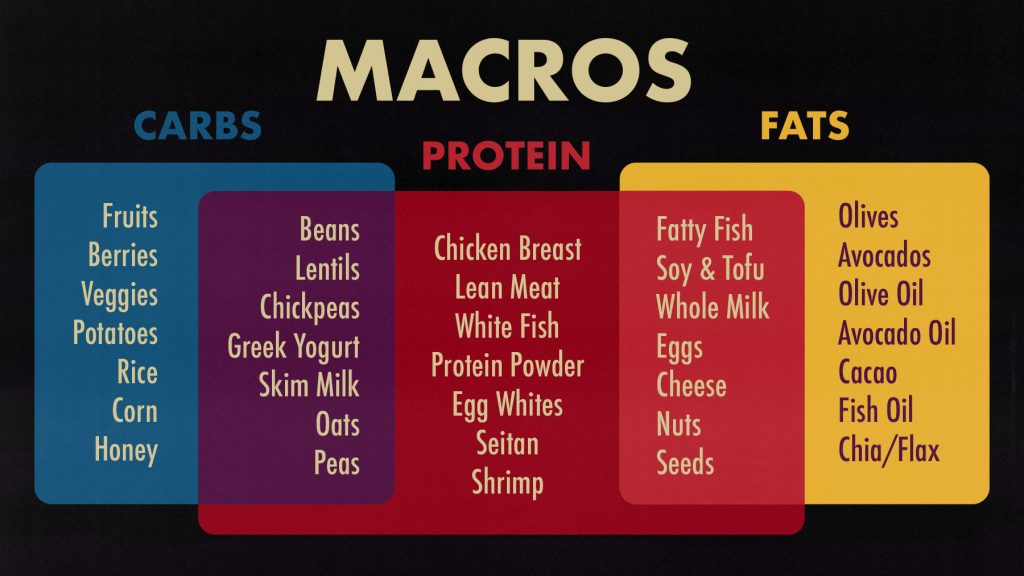
How to Count Macros: Beginner Guide
Counting macros is when you count how many grams of protein, carbs, and fat you eat. You can do that by looking at nutrition labels, weighing your food, or following recipes with pre-calculated macros. Most people plug those macros into a calorie-tracking app.
Tracking macros used to be a bodybuilding thing, but it’s become more popular over the past few years. The idea is that you need certain amounts of calories, protein, carbs, and fat to build muscle, lose fat, and be healthy. That’s true, kind of.
Macros are important, but it isn’t hard to get them right. Most cultures have found ways to eat balanced diets. Your appetite is pretty good at asking for the nutrients you need. And most macro targets are pretty forgiving.
Here’s what you need to know.
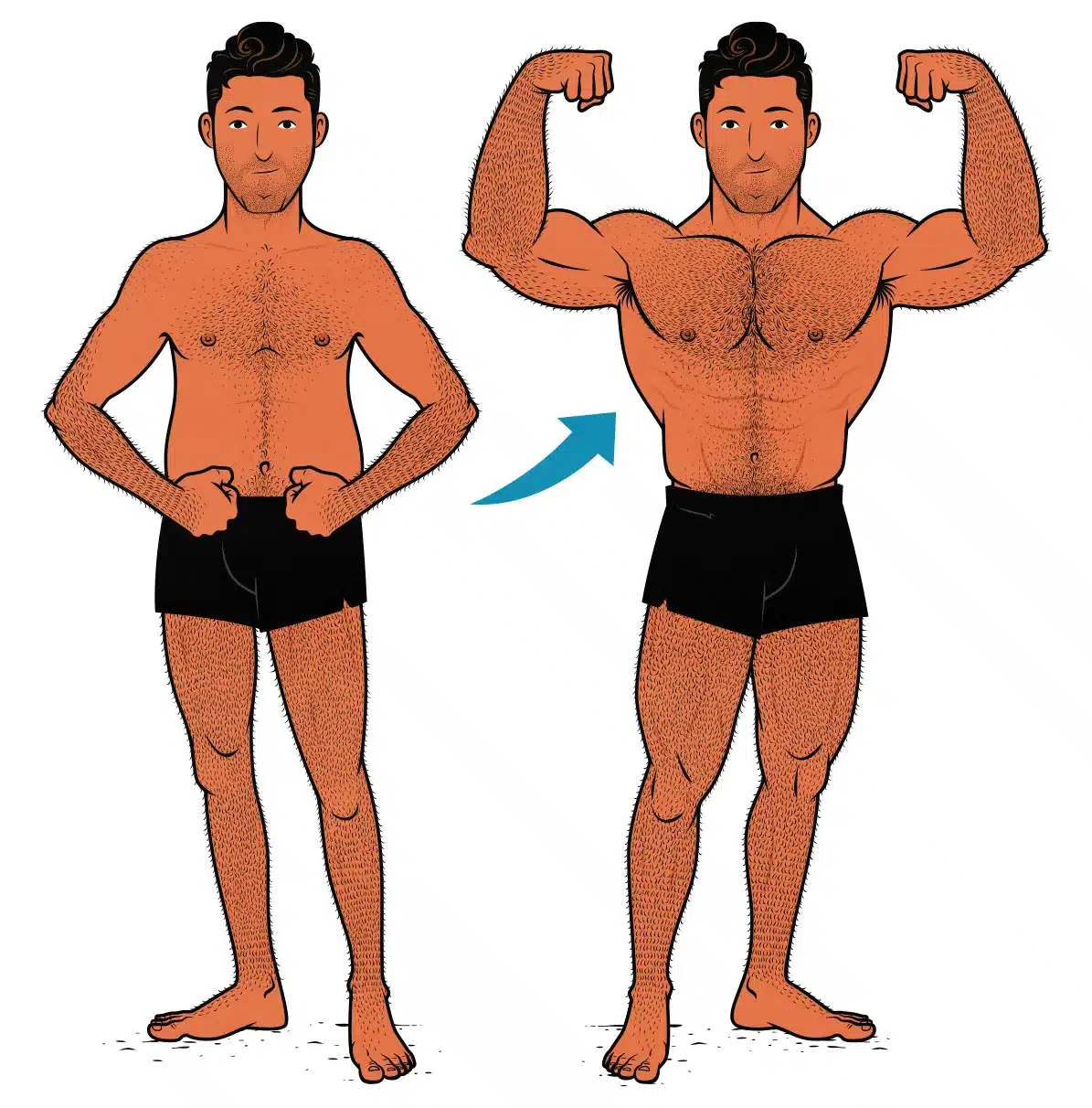
What Are Macros?
Macro is short for “macronutrients,” the three main nutrients we use for energy:
- Protein gives you the amino acids you need to build muscle, grow your hair and nails, produce enzymes, and form antibodies. It’s found in foods like meat, seafood, nuts, seeds, dairy, eggs, grains, and legumes (like beans, lentils, and soy). It has 4 calories per gram. A typical 200-gram serving of skinless chicken breast has 63 grams of protein, a few grams of fat, and 330 calories.
- Carbohydrates are your body’s preferred source of energy (unless you eat a ketogenic diet). They fuel your brain, movement, and exercise. They’re found in fruits, vegetables, grains, legumes, honey, and dairy. They have 2–4 calories per gram. A cup of cooked rice has 50 grams of carbs and 200 calories. A cup of broccoli has 6 grams of carbs and 30 calories.
- Fat can be stored as body fat, giving us access to huge reserves of energy. It keeps our cell membranes healthy, assists in absorbing fat-soluble vitamins, and helps us produce hormones. It’s found in foods like nuts, seeds, flesh, dairy, eggs, olives, avocados, and chocolate. It has 9 calories per gram, making it the densest of the macronutrients. A tablespoon of olive oil has 14 grams of fat and 120 calories.
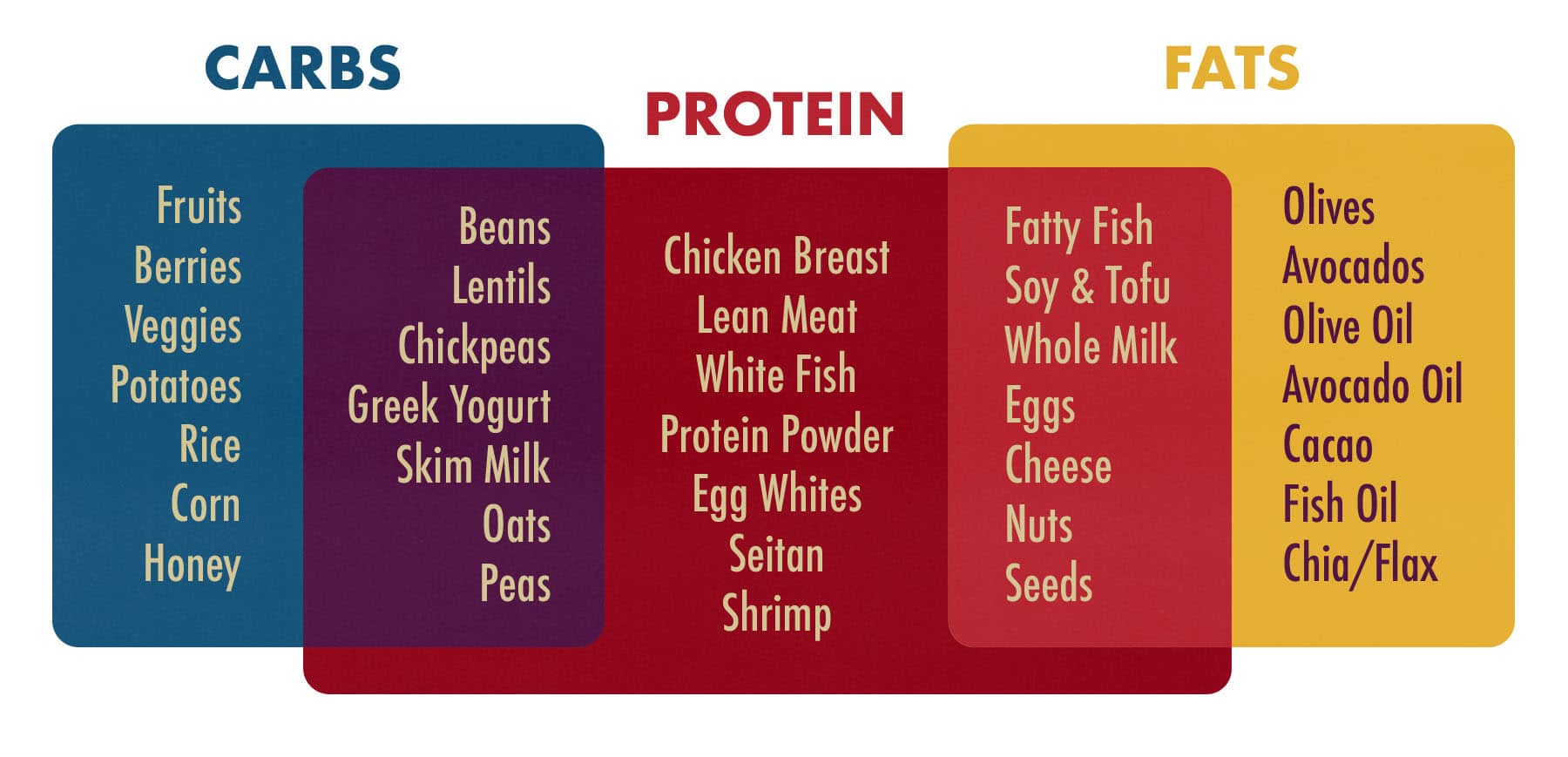
You can also get foods that are a mix of macros. For example, beans are a mix of carbs and protein. Salmon is a mix of protein and fat.
When a bodybuilder eats their classic meal of chicken breast, rice, and broccoli made with a little bit of extra virgin olive oil, they’re getting:
- Calories: 680
- Carbohydrates: 56 grams
- Protein: 70 grams
- Fat: 19 grams
If they had four meals like that every day, they’d get:
- Calories: 2,720
- Carbohydrates: 224 grams
- Protein: 278 grams
- Fat: 75 grams
That’s a fairly normal amount to eat for someone who weighs 170 pounds, works out a few times per week, and is somewhat active throughout the day. You can calculate your own macros here.
This diet is extremely high in protein, but we’re imagining a classic bodybuilder, fitness influencer, or Hollywood actor. They eat a lot of protein, even though there isn’t much benefit (or harm) to it.
If they wanted to lose a pound per week, they could start by removing 500 calories. If they wanted to gain a pound per week, they could start by adding 250–500 calories.
When people talk about tracking macros, this is what they’re doing. They’re trying to make sure they’re hitting their calorie target and getting enough protein. They might also be trying to eat enough carbs to maximize muscle fullness and strength (or trying to keep their carbs low enough to stay in ketosis). If they’re eating very few calories, they also need to make sure they’re hitting the bare minimum amount of fat for general health.
Should You Count Your Macros?
You don’t need to track your macros. You can build muscle and burn fat without knowing how many calories you’re eating or burning. That’s what most people do. It isn’t always easy, but it’s relatively simple:
- Eat balanced meals that contain protein, carbohydrates, fat, and fibre. Chicken, broccoli, and rice are balanced meals. So are smoothies, yogurt parfaits, muesli with milk, trail mix, chili con carne, paella, lentil stew, tacos, burritos, stir-fries, shawarma, dal with chapati, and a peanut butter and banana sandwich.
- Eat a nutritious diet. Favour foods that are rich in vitamins, minerals, phytonutrients, and probiotics. Eat a variety of fruits, vegetables, nuts, seeds, legumes, and whole grains. Blending them won’t make them any less nutritious. Add spices like garlic, onions, chili peppers, salt, pepper, turmeric, and cilantro. Imbibe nutritious liquids like coffee, tea, kefir, and kombucha.
- Eat similarly sized meals at similar times every day. Your meals don’t need to be exactly the same, but you should eat similar amounts at similar times. Your digestive system likes routine, and a steady routine makes it easier to eat a steady amount of food.
- Weigh yourself every week. Your weight can fluctuate, so keep the circumstances similar at each weigh-in. I recommend weighing yourself every Sunday morning right after waking up. (You could also weigh yourself every morning and take a weekly average.)
- Adust. If your weight is moving in the right direction, keep going. If you want to lose more weight (or burn more fat), eat a bit less food. If you want to gain more weight (or build more muscle), eat a bit more food.
If you’re following those four steps, you’ll get great results without needing to track your macros. So, if you don’t want to track, you don’t need to.
Tracking your macros can be helpful, though. You’ll learn how many calories you’re eating and burning, which foods contain which nutrients, and whether your diet has any major problems. For example, you might learn you’re eating too little protein, fibre, or omega-3s. Or perhaps too much sugar, salt, or saturated fat.

A decade ago, I tracked my macros for 3 months while cutting (explained here), and I’m still benefitting from that knowledge all these years later. So, if you’re curious about tracking your macros, go for it. The only downside is inconvenience, and you can stop whenever you like.
What Macros Should You Aim For?
I’ll give you a calculator in a second, but let’s start with the basic principles. If you’re trying to build a lean and muscular physique, you should eat a “balanced” diet with about 20% of your calories from protein, 50% from carbs, and 30% from fat. That’s similar to what most traditional cultures eat, just with a little more protein.
We can be more specific, though. In a 2019 study, Dr. Eric Helms gives some minimum macronutrient targets for building muscle leanly:
- Protein: 0.7 g/lb/day (1.6 g/kg/day)
- Carbohydrates: 1.5 g/lb/day (3 g/kg/day)
- Fats: 0.25 g/lb/day (0.5 g/kg/day)
These are the minimums. You can allot the rest of your calories however you like. Most people fill up with a mix of carbs and fat, usually leaning slightly more toward carbs.
The Macronutrient Calculator
Here’s a simple macro calculator. Plug in your stats and your goals, and the calculator will give you a calorie recommendation and some minimum macro targets to aim for.
Macro Calculator
These calorie and macro targets are just a starting point. You’ll need to weigh yourself every week, see if your body weight is moving in the direction you want it to, and then adjust accordingly.
I recommend adding 200 calories whenever you want to gain faster and removing 100 calories whenever you want to lose weight faster. This is the most important part. If you do this, you don’t even need to track your calories. It can still help, and I still recommend giving it a try, but you don’t need to.
How to Count Macros for Body Recomposition
We have a body recomposition macro calculator and a recomp guide. Those two articles go into more detail than this one. But here are the basics:
- Protein: It’s common to eat quite a lot of protein while recomping, but you don’t have to. Eating 0.7 g/lb/day is just as effective (meta-analysis). If you want to build more muscle, improve your weight training routine. That’s by far the most powerful stimulus.
- Carbs: Carbs pump your muscles full of glycogen, improve your workout performance, make your muscles fuller, and speed up muscle growth. Getting 30–50% of your calories from carbs is good for most people.
- Fat: You’ll easily hit your minimum fat targets. Feel free to eat much more. I recommend getting 20–40% of your calories from fat.
- Fibre: A good rule of thumb is to eat at least 10 grams of fibre per 1,000 calories, but more is often even better. Fibre is great for your digestive system, blood sugar, and blood lipids. But don’t make dramatic changes all at once.
- Food choices: You can eat a regular diet, as described in the first section of this article. You can listen to your appetite. Focus on eating nutritious foods, balanced meals, and getting into a steady rhythm.
- Protein Sources: Fish, chicken, lean ground meat, Greek yogurt, tofu, eggs, protein shakes, milk, soy milk, peanuts, and pumpkin seeds.
- Carb Sources: Fruits, berries, veggies, rice, lentils, beans, onions, garlic, popcorn, oatmeal, whole-grain pasta, whole-grain bread, muesli cereal, and honey.
- Fat Sources: Fatty fish (like salmon), avocados, olives, avocado oil, olive oil, nuts, and seeds.
- Drinks: Coffee, tea, kombucha, milk, and kefir.

I recommend weighing yourself every week so that you know how your weight is changing. You don’t really need to worry about it, though. You can let it wander where it will. It’s okay to gain or lose a little bit of weight while recomping.
At a certain point, you’ll stop making progress. Your waist circumference will stop shrinking, your arms will stop growing, and your strength will plateau in the gym. At that point, you aren’t recomping anymore. You’ll need to use a more powerful method, gearing into a cut to lose more fat or into a lean bulk to build more muscle.
How to Count Macros for Weight Loss
We have a weight-loss calorie calculator and cutting guide. Those two articles delve into greater depths than this one. But here are the basics:
- Protein: You might need to eat a little bit more protein while cutting, especially if you’re already relatively lean and muscular (as a natural bodybuilder might be). If you’re overweight, a moderate amount of protein (0.7 g/lb/day) is fine. If you’re obese, you can eat 0.7 g/lb/day based on your goal body weight.
- Carbs: It helps to eat as many carbs as you can. They improve workout performance, keep your muscles looking full, and are great for building muscle. But they’re optional. You can cut them as low as you like. Some people prefer very-low-carb “ketogenic” fat-loss diets. That’s perfectly fine.
- Fat: You don’t need to eat much to be healthy, but it’s important to hit the minimum target. For most people, that means eating at least 45 grams (about 400 calories) of fat per day. More is perfectly fine.
- Fibre: The typical rule of thumb is to eat at least 10 grams of fibre per 1,000 calories. However, when you’re cutting, you might want to bump that up. Fibrous foods are filling and nutritious, making it easier to control your cravings. I’d aim to eat more fibre than you usually do.
- Food choices: I recommend filling your belly with whole foods that take up a lot of space without having many calories. This is called having a low energy density.
- Protein Sources: Fish, chicken breast, lean meat, low-fat Greek yogurt, tofu, pumpkin seeds, and eggs.
- Carb Sources: Berries, melons, watermelons, apples, pears, lentils, beans, carrots, onions, garlic, spinach, broccoli, cauliflower, cucumbers, pickles, boiled potatoes, baked sweet potatoes, oatmeal, corn, popcorn, and peas.
- Fat Sources: Fatty fish (like salmon), avocadoes, olives, pumpkin seeds, almonds, walnuts, chia, and flax.
- Drinks: Coffee, tea, and kombucha are nutritious and flavourful while having almost no calories. Kefir is nutritious and rich in protein. Water is good, though carbonated water can help you feel fuller. Diet soda seems to be fine.
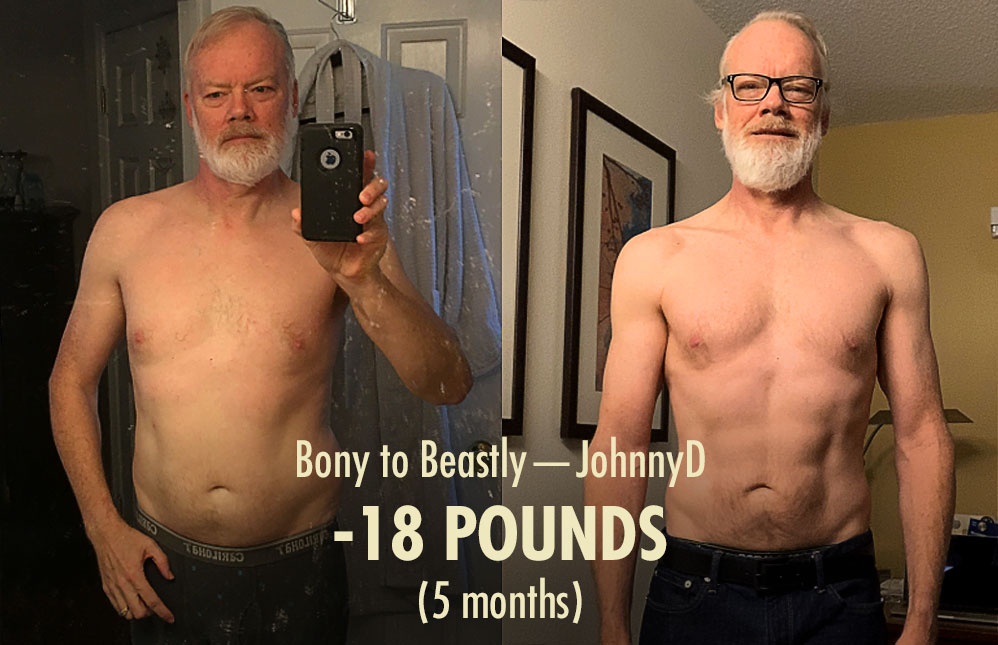
The most important thing is to weigh yourself every week and remove calories as needed. If you want to lose weight faster, eat 100 fewer calories. Keep weighing yourself and removing calories whenever you need to.
As you lose weight, your metabolism will slow because: you’re carrying less body weight around, your body doesn’t need to support as much tissue, and your activity levels will probably decrease. You can offset this by building muscle (which burns about 3x more calories per pound than fat) and staying active. A good way to monitor your activity levels is to track your step count (using an app, fitness tracker, or pedometer). 8,000 steps per day is a good minimum target for general health.
At a certain point, your diet might become so low in calories that it becomes miserable to sustain. Maybe your caloric budget shrinks to the point where you can’t even meet your minimum macro targets. At that point, you can take a break. You might also want to spend some time focusing on muscle growth, maybe even eating in a slight calorie surplus (aka lean bulking). Your metabolism will recover quickly.
How to Count Macros for Muscle Growth
We have a bulking calorie calculator and a beginner bulking guide. Those two articles go into more detail than this one. But here are the basics:
- Protein: You don’t need that much protein while bulking. 0.7 g/lb/day is a good minimum target, and with all the food you’re eating, you’ll probably hit it quite easily. There’s no benefit to eating even more protein, but you can if you want to.
- Carbs: Eating plenty of carbs will pump your muscles full of glycogen, improving your workout performance, making your muscles fuller, and speeding up muscle growth. They also make it easier to eat enough calories to gain weight. You probably want to get about 40–60% of your calories from carbs while bulking.
- Fat: It’s extremely easy to eat enough fat while bulking. If you have a preference for high-fat foods, you may even need to cut back a little bit. Generally, you want around around 20–40% of your calories from fat. More isn’t the end of the world, though.
- Fibre: A good rule of thumb is to eat at least 10 grams of fibre per 1,000 calories. That’s especially helpful while bulking. Having fibre in every meal will help to regulate your blood sugar, blood lipids, and energy levels. It will also keep your digestive system running smoothly. However, don’t radically increase your fibre intake all at once. It’s better to increase your fibre intake gradually.
- Food choices: I recommend eating nutritious meals that are high in calories, aren’t very filling, and digest relatively quickly and smoothly. Here are some bulking recipes you might like.
- Protein Sources: Fatty fish, chicken, lean ground meat, Greek yogurt, protein shakes, milk, soy milk, tofu, peanuts, and eggs.
- Carb Sources: fruit and yogurt smoothies, mangoes, bananas, white rice, brown rice, whole-grain pasta, whole-grain bread, lentils, beans, oatmeal, corn, peas, milk, dried fruits, granola, muesli cereal, and honey.
- Fat Sources: Fatty fish (like salmon), fish oil, extra-virgin olive oil, avocado oil, cheese, pumpkin seeds, nuts, peanuts, and peanut butter.
- Drinks: Coffee, tea, milk, smoothies, and kefir. Protein shakes with ground flax.
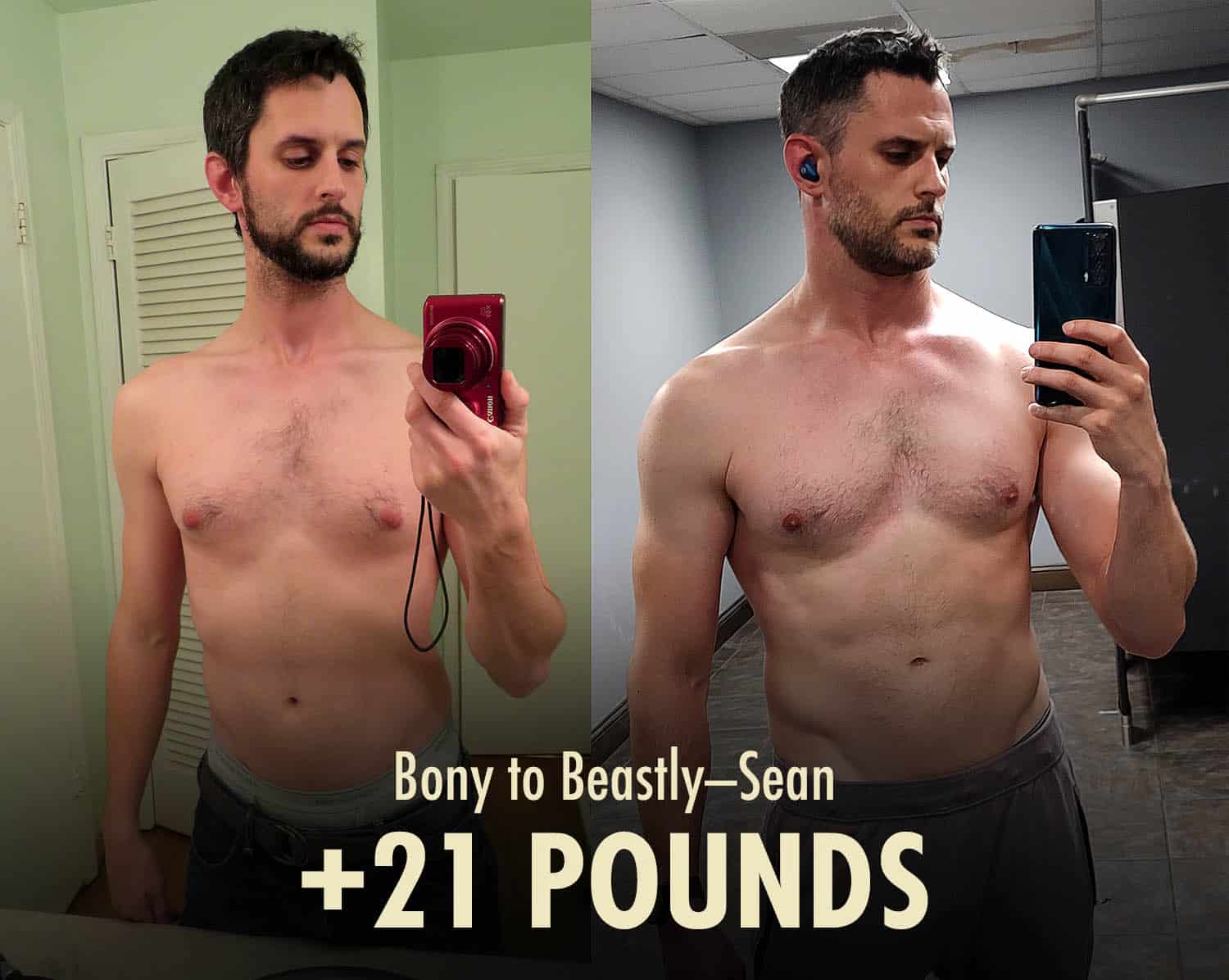
The most important thing is to weigh yourself every week and add calories as needed. If you want to gain weight faster, eat 200 more calories. Keep weighing yourself and adding calories whenever you need to. If you do this, you don’t even need to track your macros.
As you gain weight, your metabolism will speed up: you’re carrying around more body weight, you need to support more muscle mass, and your activity levels will probably increase. You could offset some of that by being less active (less cardio and fewer steps), but that wouldn’t be very good for you. It’s better to eat more calories.
If you’re a skinny “hardgainer” sort of person (like me) then bulking can be pretty difficult, especially as the months add up. I recommend bulking for at least 3 months, and ideally more like 6–8 months, but you can take a break at any time. Your metabolism will slow down. It won’t be difficult to maintain your gains. See this article.
How to Track Your Macros Without an App
You can track your macros without an app. The easiest way to do that is to use recipes. For example, in our muscle-building program, we have a recipe book full of healthy recipes with all the calories and macros calculated ahead of time. All the meals are optimized for muscle growth.
You can look at the nutrition labels on the foods you eat. Tallying up nutrition labels sounds like it would be a hassle, but most people eat similar meals most days. After a few days of keeping track, you’ll know the macros of the meals you eat.
You can also get rough estimates from LLMs like ChatGPT. If you tell it what you eat, it’s pretty good at spitting out rough estimates of how many calories and macros you’re eating. It isn’t perfect, but casually tracking your calories works almost as well as rigorously tracking your calories, so that’s usually okay.
You might want to use an app, though. Even if you’re following recipes, sometimes it’s nice to let an app tally up the totals. Sometimes it’s fun to work towards your calorie total. Apps definitely have their place.
The Best App for Tracking Macros
The most popular free macro-tracking app is My Fitness Pal. I used it a decade ago when I was tracking my calories, and it worked. However, some of the newer apps are much better.
RP Diet Coach (headed by Dr. Mike Israetel) and Carbon Diet Coach (headed by Dr. Layne Norton) are pretty good. They use verified food databases, they’re relatively easy to use, and all of the recommendations are sensible and rooted in good research. Layne Norton is also a world-class powerlifter and bodybuilder, so he’s got the personal experience to back it up.
I think Macrofactor (headed by Greg Nuckols) is the best. I’ve written a full review here. It’s by far the best at tracking how your weight is changing and adjusting your calorie targets accordingly. That’s the most important part of tracking your calories. It’s also the prettiest and easiest to use, which helps.
Mind you, I’m biased. Greg Nuckols founded my favourite research review (MASS), runs one of the most respected lifting sites (Stronger by Science), and we’ve been online acquaintances for almost a decade now. He’s helped us write a few different articles over the years. He also asked me for feedback when he first launched Macrofactor. I criticized a couple of things (as explained in the review article), and he listened, and he fixed them.
We became affiliates, and we’ve now had around 500 clients use Macrofactor. Their feedback has been mostly great. There have been a few issues. However, almost all of those issues have been fixed. The only lingering issue is that it initially underestimates how many calories some skinnier people need to gain weight. The fix for that should be coming within the next couple of months.
If you want to try Macrofactor, you can get an extended free trial with the code “b2b”. I should reiterate that you don’t need to track your calories, though. All of this is entirely optional.

Alright, that’s it for now. If you want us to walk you through the process of building muscle, losing fat, or doing both at once, check out our Bony to Beastly Program or Outlift Intermediate Hypertrophy Program. Both of them include a full workout routine, diet guide, and lifestyle recommendations. We’ll also give you a recipe book full of nutritious meals with all of the calories and macros calculated out for you. And they include coaching from us in our online community.


Muscle-Building Mini-Course via EMAIL
Sign up for our 5-part muscle-building mini-course that covers everything you need to know about:
Here are some related articles